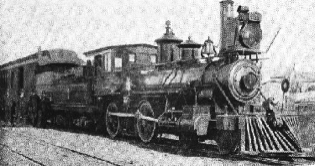Paragould Southeastern Railway
During 1893, an agreement was entered into on June 14 with Bertig Brothers and J. F. Hasty and Sons, operators of the Paragould Southeastern Railway Company, in which the St. Louis Southwestern surrendered $25,000 in first mortgage bonds of the Paragould and Buffalo Island Railway, predecessor of the Paragould Southeastern in first mortgage bonds of the

new company. Provisions in the contract required that the line be extended across the St. Francis River to lands owned by Bertig Brothers.
This road was incorporated October 11, 1887, as the Paragould and Buffalo Island Railway Company, and given the right to construct a narrow-gauge tram-road eastward from Paragould, Arkansas, about eight miles. According to legend, the road was built on logs with wooden rails and operated by a concern known as the Tennessee Factory Company. There was one locomotive named Cassie after the daughter of the company's attorney and surveyor, J. B. Boykin.
The primary reason for constructing this tram-road was to provide a means of getting bolts and materials to Paragould for operation of the Ware-Rossen Stave Mill. Henry Wrape was made receiver of this mill, and sold the property to J. F. Hasty and Sons in 1888. The road remained idle for a short time until Henry Wrape Company and Bertig Brothers induced the Cotton Belt to furnish them with thirty-five pound rails and a narrow gauge locomotive. On November 13, 1893, the name of the road was changed to Paragould Southeastern, and extensions of the line were made to Cardwell and Hornersville, Missouri, and to Blytheville, Arkansas, in the years 1895, 1897, 1903, and 1907. The line was changed to standard gauge in 1893, and thereafter operated as an independent company.
Although the Cotton Belt had controlling interest in the Paragould Southeastern Railway Company after 1893, it was not until January 1, 1914, that the road was officially absorbed.
The Southeastern Railway Engine #1 (4-4-0) was nicknamed “Cassie.”

